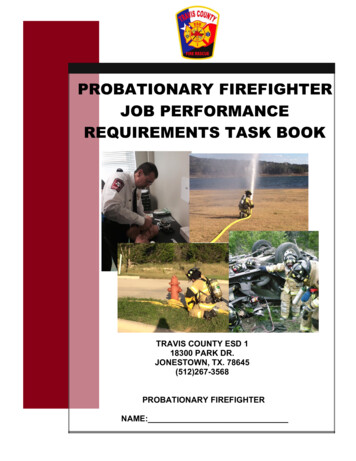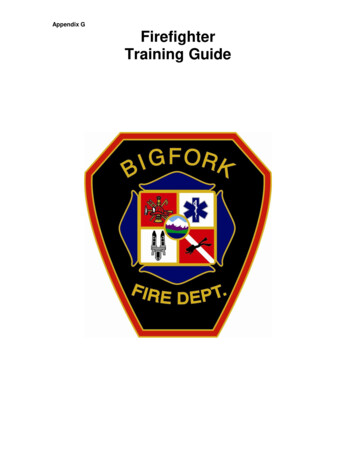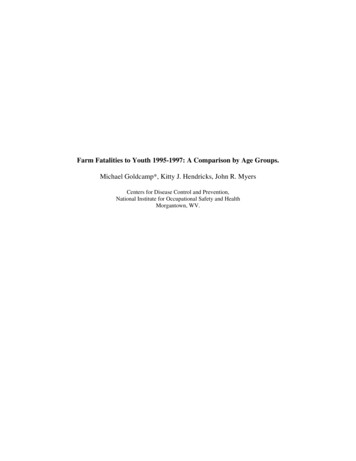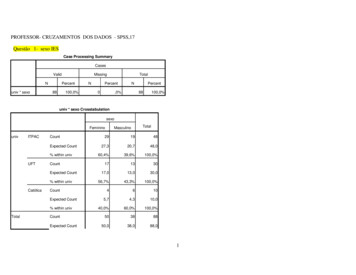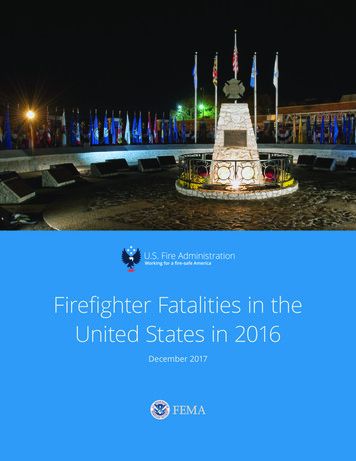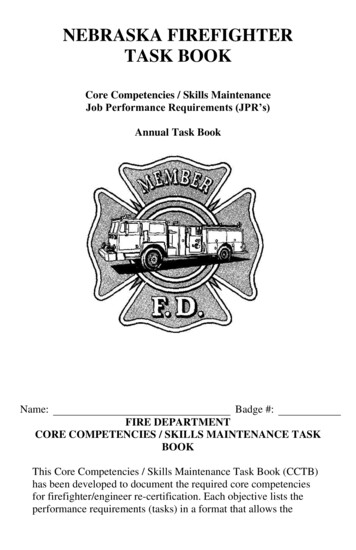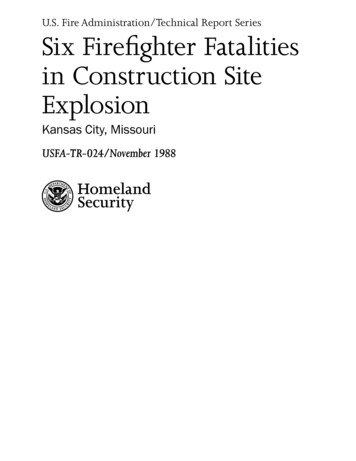
Transcription
U.S. Fire Administration/Technical Report SeriesSix Firefighter Fatalitiesin Construction SiteExplosionKansas City, MissouriUSFA-TR-024/November 1988HomelandSecurity
U.S. Fire Administration Fire Investigations ProgramThe U.S. Fire Administration develops reports on selected major fires throughout the country.The fires usually involve multiple deaths or a large loss of property. But the primary criterionfor deciding to do a report is whether it will result in significant “lessons learned.” In somecases these lessons bring to light new knowledge about fire--the effect of building construction orcontents, human behavior in fire, etc. In other cases, the lessons are not new but are serious enoughto highlight once again, with yet another fire tragedy report. In some cases, special reports are developed to discuss events, drills, or new technologies which are of interest to the fire service.The reports are sent to fire magazines and are distributed at National and Regional fire meetings. TheInternational Association of Fire Chiefs assists the USFA in disseminating the findings throughout thefire service. On a continuing basis the reports are available on request from the USFA; announcements of their availability are published widely in fire journals and newsletters.This body of work provides detailed information on the nature of the fire problem for policymakerswho must decide on allocations of resources between fire and other pressing problems, and withinthe fire service to improve codes and code enforcement, training, public fire education, buildingtechnology, and other related areas.The Fire Administration, which has no regulatory authority, sends an experienced fire investigatorinto a community after a major incident only after having conferred with the local fire authoritiesto insure that the assistance and presence of the USFA would be supportive and would in no wayinterfere with any review of the incident they are themselves conducting. The intent is not to arriveduring the event or even immediately after, but rather after the dust settles, so that a complete andobjective review of all the important aspects of the incident can be made. Local authorities reviewthe USFA’s report while it is in draft. The USFA investigator or team is available to local authoritiesshould they wish to request technical assistance for their own investigation.This report and its recommendations were developed by USFA staff and by TriData Corporation,its staff and consultants, who are under contract to assist the USFA in carrying out the Fire ReportsProgram.USFA wishes to acknowledge the support and cooperation of the Regional Director and staff ofFEMA’s Region VII office in Kansas City and the Kansas City Authorities without whose permissionand wholehearted cooperation this report would not have been written. In particular we wish toacknowledge the cooperation and assistance of Assistant Chief Manager Raymond E. Shipman, ChiefEdward W. Wilson (Chief of Department), Chief Robert L. Wallace (Fire Marshal), and City AttorneySam Mumma.For additional copies of this report write to the U.S. Fire Administration, 16825 South Seton Avenue,Emmitsburg, Maryland 21727. The report is available on the Administration’s Web site at http://www.usfa.dhs.gov/
Six Firefighter Fatalitiesin Construction Site ExplosionKansas City, MissouriInvestigated by: Jack YatesThis is Report 024 of the Major Fires Investigation Project conductedby TriData Corporation under contract EMW-88-C-2649 to the UnitedStates Fire Administration, Federal Emergency Management Agency.HomelandSecurityDepartment of Homeland SecurityUnited States Fire AdministrationNational Fire Data Center
U.S. Fire AdministrationMission StatementAs an entity of the Department of HomelandSecurity, the mission of the USFA is to reduce life and economic losses due to fireand related emergencies, through leadership, advocacy, coordination, and support.We serve the Nation independently, in coordination with other Federal agencies,and in partnership with fire protection andemergency service communities. With acommitment to excellence, we provide public education, training, technology, and datainitiatives.HomelandSecurity
TABLE OF CONTENTSOVERVIEW . . . . . . . . . . . . . . . . . . . . . . . . . . . . . . . . . . . . . . . . . . . . . . . . . . . . . . . . . . . . . . . . . . 1SUMMARY OF KEY ISSUES. . . . . . . . . . . . . . . . . . . . . . . . . . . . . . . . . . . . . . . . . . . . . . . . . . . . . . 2THE INCIDENT. . . . . . . . . . . . . . . . . . . . . . . . . . . . . . . . . . . . . . . . . . . . . . . . . . . . . . . . . . . . . . . 3THE CONSTRUCTION PROJECT SITE. . . . . . . . . . . . . . . . . . . . . . . . . . . . . . . . . . . . . . . . . . . . . 4CITY, STATE, AND FEDERAL CODES AND GUIDELINES . . . . . . . . . . . . . . . . . . . . . . . . . . . . . . . 5LABELING AND CODING OF STORAGE FACILITIES FOR EXPLOSIVES ANDBLASTING AGENTS . . . . . . . . . . . . . . . . . . . . . . . . . . . . . . . . . . . . . . . . . . . . . . . . . . . . . . . . 6FIREFIGHTER HAZMAT TRAINING. . . . . . . . . . . . . . . . . . . . . . . . . . . . . . . . . . . . . . . . . . . . . . . 7ANALYSIS OF THE AWARENESS OF THE CREWS AS TO THE DANGER . . . . . . . . . . . . . . . . . . . . 8EMERGENCY RESPONSE GUIDEBOOK (DOT P 5800.4) AND MATERIAL SAFETYDATA SHEETS . . . . . . . . . . . . . . . . . . . . . . . . . . . . . . . . . . . . . . . . . . . . . . . . . . . . . . . . . . . . . 9LESSONS LEARNED. . . . . . . . . . . . . . . . . . . . . . . . . . . . . . . . . . . . . . . . . . . . . . . . . . . . . . . . . . . 10RECOMMENDATIONS FOR FEDERAL ACTION. . . . . . . . . . . . . . . . . . . . . . . . . . . . . . . . . . . . . 12Federal Agencies Act Following Kansas City Explosion . . . . . . . . . . . . . . . . . . . . 14
Six Firefighter Fatalities in Construction Site ExplosionKansas City, MissouriNovember 29, 1988Local Contacts:Chief Edward W. WilsonChief Robert L. Wallace, Fire MarshalHarold M. Knabe, Public Information OfficerKansas City, Missouri Fire Department414 East 12th Street, 22nd FloorCity Hall BuildingKansas City, MO 64106(816) 274-1393Sgt. William ForbesBomb and Arson UnitKansas City Police Department1525 Holmes StreetKansas City, MO 64108(816) 234-5310OVERVIEWThe Kansas City, Missouri Fire Department lost six firefighters and their vehicles – two entire pumpercompanies – in an explosion that occurred while they were extinguishing a fire at a constructionsite. The fire involved a trailer/magazine containing blasting mixtures of ammonium nitrate and fueloil, most containing aluminum pellets, too. The fire also involved two other vehicles and ultimatelya second trailer/magazine that also exploded. A summary of the incident’s key issues is present intable form on the following pages.The firefighters were not told specifically what was in the trailer/magazine, but had been cautionedby the dispatcher about explosives on the site. Exactly what they suspected was in the trailers willprobably never be know.The two captains and four firefighters involved were highly experienced. Four of the six had attendedNational Fire Academy (NFA) field courses on hazardous materials (Hazmat) identification. Theyalso had Department of Transportation (DOT) Hazardous Materials Guidebooks in their vehicles.
However, the trailers/magazines containing the blasting agents probably had no markings or placards indicating their contents, and the crews may never have been sure of what was in them, especially since other, prominently marked magazines were present and may have been misconstruedto contain all the dangerous materials. The fire department was not aware of the presence of thetrailers/magazines or their contents before the incident due to a lack of jurisdictional authority andbecause the city’s Fire Prevention and Protection Code did not require the city engineer to notifythe fire department that blasting permits had been issued. (This was immediately changed after theincident.) More importantly, the Kansas City Fire Department had no authority or responsibility toinspect the site because it was a State enclave.Furthermore, it is not clear that if the personnel on the scene had known of the presence of the blasting agent (ammonium nitrate mixed with fuel oil), their Hazmat training or their use of the DOTGuidebook would have necessarily led them to behave differently than they did.SUMMARY OF KEY ISSUESIssueCommentsCauseArsonCasualtiesSix firefighters killed in explosion while fighting magazine/trailer fire.Property TypeState of Missouri highway construction site with explosives in magazines and 50,000lbs. of ammonium nitrate/fuel oil mixture (most with aluminum pellets) stored in twotrailers/magazines.Fire Department Awareness ofExplosives on SiteFire department had not been involved in blasting permit process and was unaware ofexplosives on the site prior to the incident. Nor did the department have jurisdictionalauthority over the site.Dispatcher was told of presence of explosives, but not what was stored, nor where.Firefighters’ Awareness ofExplosives on SiteBoth pumper companies were told of explosives on the site by the dispatcher, but nothingspecific.Trailers/magazines probably were not placarded nor marked to indicate contents. Theywere not required by the Bureau of Alcohol, Tobacco and Firearms (ATF) to be markedwhen parked on site.Firefighter Hazmat TrainingFour of the six firefighters killed had taken NFA field Hazmat courses.Course materials do not appear to place sufficient emphasis on explosive hazard of fighting fires involving ammonium nitrate.Emergency Response GuidesFormat and sequence of DOT Guidebook may not be sufficiently clear in an operationalenvironment.Material Safety Data Sheet (MSDS) clearly says flee this type of fire.ATF PolicyWhile there is no official AFT policy against placarding, there appears to be a generallyaccepted practice in the field of removing placards when not in transit.Jurisdictional IssuesState highway site is not under city control regarding permits or inspections, according tothe city attorney.ATF has universal jurisdiction over explosives except during transportation, but does notordinarily inspect or issue permits for sites.Local fire departments are almost always the first responder, have their personnel at risk,yet do not always have regulatory control or guaranteed coordination from other agencies.
USFA-TR-024/November 19883THE INCIDENTOn November 29, 1988, an alarm was received at 0340 by the Kansas City, Missouri Fire Departmentindicating there was a fire at a highway construction project. The caller, a night guard at the site,initially stated that there was a “small pickup truck” burning. In the background a woman could beheard saying “the explosives are on fire.” The woman was later identified as another guard. The caller went on to say “ there’s a fire on both sides of the highway.” Then, in response to thedispatcher asking “What’s burning?” the caller said: “Uh, there may be some – there’s some explosives up on a hill that I also see now is burning.”The dispatcher then directed Pumper 41 to respond to the pickup truck fire. He added: “Pumper41, use caution on your call. There’s information there may be explosives. It’s in a constructionarea ” (Editor’s underlining here and elsewhere in quotes.)Pumper Company 41 was dispatched and, upon arriving at 0346, found that there were in fact twoseparate fires. It radioed dispatch at 0347 to send another pumper company.When the second company, Pumper 30, arrived, at 0352, at the second fire, which was several hundred yards away, the first company called dispatch and stated that there seemed to be two arson firesand requested that the police be sent. The first-in company also asked dispatch to warn the secondcompany of explosives.“If you can get 30, tell them there’s a trailer on fire up there, stay away from it There’s supposed to be explosives involvedin this.” This was at 0357, five minutes after the second company had arrived. Pumper 41 also askedthat a battalion chief be sent “emergency.”At 0359, Pumper 30 asked the dispatcher, “Can you confirm that there is explosives in this trailer or not?” Thedispatcher responded, “Pumper 41 advised that, and we have additional information on the original call that there wereexplosives in that area, use caution.”To recap, at this point, both units had been advised that there were explosives on the scene, and bothhad acknowledged this. But they had not been told specifically that the trailer was a magazine withexplosives, nor what might be on the site. They gave no indication they had seen a placard, nor thatthey realized the “trailer” was a magazine, nor that they knew the contents. They also did not seemalarmed. The first company extinguished the fire in the pickup truck and proceeded to the other fireto assist the second company. A truck, a “trailer,” and a compressor – three separate vehicles – wereon fire at this time (about 0402). Pumper 41 also requested that a four-wheel drive squad be sent.However, as indicated above, they appeared to have been aware that there might be explosives in thetrailer.At 0404, Pumper 41 called to Battalion Chief 107, who was en route to the scene: “Apparently thisthing’s already blowed up, Chief. He’s got magnesium or something burning up here.” (They mayhave been seeing sparks from the aluminum sides of the trailer burning.)At 0408, approximately 22 minutes after the first pumper company arrived on the scene and approximately 16 minutes after the second company arrived on the scene a catastrophic explosion occurred.All six firefighters assigned to both companies were killed. The battalion chief and his driver whoA transcript of the dispatcher’s tape recording was prepared for this investigation by a court-qualified stenographer.Excepts are attached in Appendix A.
had just arrived and stopped about a quarter mile away received minor injuries. Their windshieldwas blown in.After the first explosion, the battalion chief immediately pulled back and prevented other firefightersfrom entering the area. A command post was set up at a safe distance.Approximately 40 minutes later, a second explosion occurred, followed by several minor explosions.The explosions broke windows far from the site and were heard through a wide area.There were two large craters found where the two trailers had been. The first trailer explosion created a swimming pool-like crater, with a “deep part” 80 feet in diameter and eight feet deep connected to a smaller crater 20 feet in diameter and six feet deep. The second trailer explosion created acrater approximately 100 feet in diameter and eight feet deep. (See aerial photo in last Appendix.)Information received from the Kansas City Fire Department is that the first explosion involved atrailer/magazine with a split load. One end had approximately 3,500 pounds of ammonium nitrate/fuel oil mixture. The remainder of the load was approximately 17,000 pounds of ammoniumnitrate/fuel oil mix with 5 percent aluminum pellets. The second explosion was a trailer/magazineloaded with approximately 1,000 30-pound “socks” of ammonium nitrate/fuel oil mixture with 5percent aluminum pellets.THE CONSTRUCTION PROJECT SITEThe project under construction was the Bruce R. Watkins Memorial Drive; more specifically, an areanear the intersection of U.S. Highway 71 and 87th Street in Kansas City, Missouri. (See Appendix B.)The highway project required the moving of substantial quantities of limestone that was routinelybroken up by drilling holes into the rock, placing a blasting agent in the holes, and then detonatingit. Kansas City has large quantities of limestone throughout the area, and there were in face severallimestone quarry operations going on.Professionals who deal with blasting have indicated that high explosives such as dynamite are tooexpensive to use as the routine blasting material. There also is greater instability with high explosivesas opposed to blasting agents.One of the most common blasting agents used throughout the United States is a mixture of ammonium nitrate with fuel oil. The common name for the product is ANFO, although it can be marketedunder other names by individual manufacturers. If a more powerful explosive is needed, aluminumdust or pellets can be blended in. This creates a “hotter” load. Reportedly, of the approximately50,500 pounds of ammonium nitrate/fuel oil mixture involved in these explosions, 47,000 poundscontained the mixture of 5 percent aluminum.Personnel at the construction site indicated they used between 10,000 and 16,000 pounds a dayon the average. The material came in 30-pound socks that were placed into the drilled holes, thendetonated with a device such as a blasting cap.The material was divided between two trailers/magazines less than 100 feet apart. There were nobuilt-up berms or barriers between the trailers. Section 55.218, Table of Distances for Storage ofExplosive Materials in the ATF Explosives Law and Regulation Handbook, states that with 25,000to 30,000 pounds of explosives there must be a distance of 224 feet between trailers/magazines ifunbarricaded.
USFA-TR-024/November 19885The trailers/magazines were less than 600 feet from Highway 71 and less than 350 feet from 87thStreet. There was a berm between the trailers/magazines and Highway 71. The minimal distancefrom Highway 71 should have been 933 feet.There was not a berm between the trailers/magazines and 87th Street. Elevation of the land issuch that the trailers/magazines were above most of the street. Traffic on this street is less than onHighway 71. If it was considered a class A to D highway, the minimal distance should have been 680feet. National Fire Protection Association (NFPA) 495, Table of Distances for Storage of Explosives,generally agrees with the ATF Handbook distances. (See Appendix C.)The Kansas City Office of the ATF described ANFO as one of the safest blasting materials in use. Itsvolatility comes about when it is enclosed or is in a “compressed area.” If it then ignites, it has substantial explosive capabilities. This may explain the delayed ignition of the second trailer. The stability of the ANFO may have kept it from exploding from a shockwave and flying debris, but tires andwooden parts of the trailer/magazine may have ignited, eventually causing the ensuing explosion.The ammonium nitrate mixtures were stored in two appropriate “Type 5” trailers/magazines specifically designed to transport and store blasting agents. The trailers were in the open, not enclosed inany fencing. According to workers from the site, the trailers were not placarded when stored. Asnoted earlier, there is no evidence in the dispatcher tapes that the crews saw any placards or any otherinformation on the trailers as to what they held.Appendix N has a photograph of a typical Type 5 trailer/magazine from the same blasting agentmanufacturer in use at another site in Kansas City at the time of the explosion. The permanentlyattached, foldable placards on the back of the trailer were in the “up” (covered) position. It is standard industry policy, according to the president of a blasting mixture company, to place placardsdown when the trailers leave the plant loaded, and to turn them up when they park on a site. Havingplacards covered or removed on site would not have been in violation of existing ATF regulations.The separation distances were in violation of ATF regulations. (See Appendix D for excerpts fromthe ATF regulations.)Also on the site were two yellow high-explosive magazines used to store dynamite and blasting caps.(They appear in the aerial photo in the last Appendix.) It is possible that the crews on the scene sawthese other magazines and thought they were the “explosives” referred to by the dispatcher. However,they did continue to question the contents of the trailer. One of the firefighter’s bodies was found inthe vicinity of one of these containers with a portable hand radio nearby. It is thought possible (butis again speculation) that he was scouting these magazines when the explosion occurred. CITY, STATE, AND FEDERAL CODES AND GUIDELINESAt the time of the explosion, Kansas City had adopted the Uniform Fire Code, 1982 Edition, for fireprevention and protection. Article III, Blasting, Section 14.33 Permit-Required, states that anyone doingany blasting within the city limits shall obtain a permit from the city engineer. (See Appendix E.)All permits issued were under the Kansas City fire code, but there was nothing in the regulationsrequiring the City Engineer’s Office to notify the Kansas City Fire Marshal’s Office of any blastingA “compressed area” means a small, packed space like the cylindrical hole used in blasting.The condition of the deceased suggested that he was not near the trailer when it blew and was killed at a distance bythe blast wave.
operations. Also, the permit application did not require specific information in regard to type, quantity, or site location of the explosives to be employed.An additional jurisdictional problem appears to exist regarding “State Enclave” legislation. The CityAttorney’s Office rendered an opinion after this incident that, based on the provisions of Article IV,Section 29 of the Missouri Constitution and Section 227.030, RSMo (1986), the city has “no rightswhatsoever” to enforce its code on State highway projects or their contractors (See Appendix F).The city should not issue permits or do any construction inspection or supervision on the projects.Thus, the City Fire Marshal’s Office faces the dilemma between what it would like to do and what itcan legally enforce. And the city engineer apparently did not have jurisdiction to issue the permit itdid!Since the explosion, the Kansas City Fire Marshal’s Office has implemented changes that allow itto become cognizant of blasting material and blasting projects within their jurisdiction. All blasting permits now must be cleared through the Fire Marshal’s Office, as well as the city engineer.Additionally, permit applications now require a more extensive description of the site project, thematerial being used, how it is stored, and a plot diagram showing storage locations (see AppendixG). Hazmat permits already were being registered in the Kansas City Alarm Office. Unusual conditions within structures (e.g., wild animals, people with physical impairments, and Hazmat) havelong been maintained in a computer file there.ATF – The role of ATF with respect to codes and enforcement is described in their explosives lawand regulation handbook, ATF P 5400.7 (11/82). ATF oversees the manufacturing of explosives andthe licensing of any user of explosives. They have the authority to regulate and inspect at all times.However, they seldom are able to inspect all user locations simply because of staffing shortages andthe mobility of user sites. Many inspections are done in response to reported compliance failures orother reported incidents.Because they have not been provided with adequate resources, ATF has little choice but to adopt apassive approach to enforcing their regulations, placing the burden of compliance on affected individuals or organizations.Under Section 843(b)(5) of the ATF handbook, user applicants must demonstrate and certify inwriting that they are familiar with State laws and local ordinances relating to explosive materials forthe location in which they intend to do business. ATF is not under any obligation to inform the firemarshal or fire department about any explosive material over which they have regulatory power. ATFdoes not issue site specific permits or licenses; rather, the license is issued to the user. Local codedoes not supersede ATF guidelines, though the ATF handbook implies that users should comply withlocal codes. (See Appendix D.)LABELING AND CODING OF STORAGE FACILITIES FOR EXPLOSIVES ANDBLASTING AGENTSOne special codes and enforcement issue pertinent to this incident was the requirement – or lack ofrequirement – for labeling the trailers/magazines.There are three classes of explosive material: high explosives (for example, dynamite); low explosives (for example, fuse lighters); and blasting agents (for example, ammonium nitrate/fuel oilmixture). The class of explosive dictates the type of magazine in which it is to be stored accordingto ATF guidelines. Types 1, 2, and 3 are magazines for high explosives. Type 4 is for low explosives.These four types of magazines are normally of smaller, heavier construction and brightly colored.
USFA-TR-024/November 19887Type 5 magazines are for blasting agents and were in use on this site and involved in the two explosions. Blasting agents are typically stored in large quantities and are delivered in mobile Type 5magazines which usually are owned by the manufacturers of the material (as in this incident) andhave the appearance of a standard freight trailer. It may be a single or double axle trailer, dependingon the load amount. (See Appendix H for Type 5 magazine storage requirements and constructionexhibits.)While the blasting agent is en route from the manufacturer to the user site, it is subject to regulationby the U.S. DOT. DOT regulations state that the vehicle must be placarded for identification purposes.This is the only time the explosive material is not directly under ATF jurisdiction. Once the Type 5mobile magazine is parked, it is again under the jurisdiction of ATF. At this point the DOT placardsusually are removed (or folded up), creating the problem of identification of contents.The logic behind ATF’s not requiring labeling of Type 5 magazines when parked is that they are lesssusceptible to theft and vandalism if they are not readily identified. By appearing as innocuous trailers, fewer people know what they contain. Unfortunately, as tragically illustrated here, this lack ofknowledge also applies to firefighters.One reason for this orientation toward confidentiality is that the ATF’s regulations and the act thatrequires them were prompted primarily by the nationwide concern in the early 1970’s over domestic terrorism.Thus, while not officially opposed to placarding on site, the AFT regulations do not require them anddo not address the issue. Furthermore, the removal of placards from trailers/magazines upon arrivalon site appears to be accepted practice in the field.The NFPA standard for “Manufacture, Transportation, and Storage of Explosive Materials – 1985”(NFPA 495) requires in Section 6-4,6 that “the local fire department be notified of the locationof all magazines ” The standard also requires in Section 6-85 that the property on which “Type1 and outdoor Types 2, 4, and 5 are located be posted with signs reading ‘Explosives – Keep Off’.”The standard does not, however, require placarding or marking of the Type 5 magazines themselvesor identification of the explosives. (See Appendix I.)FIREFIGHTER HAZMAT TRAININGFour of the six firefighters involved in this explosion, including both company officers, had receivedsome exposure to Hazmat training through NFA field courses. Four had completed the NFA course,“Recognizing and Identifying Hazardous Materials.”The stated scope of this course is “to develop and basic skills with which to identify hazardous materials problem in their communities, to recognize hazardous materials presence, and to identify thespecific hazardous material(s) and associated hazard characteristics.” (See Appendix J for excerptsfrom NFA courses.)The course stresses firefighter safety in Hazmat incidents. The acronym “D.E.C.I.D.E.” is used repeatedly throughout the course text to guide the student through the emergency intervention process andto minimize personal risk. It stands for “Detect hazardous material presence; Estimate likely harm(without intervention); Choose response objectives; Identify action options; Do the best option; andEvaluate process.” There are protective measures discussed throughout the course, all advising tocontinually exercise caution.
Much material in this course deals with problems encountered with transportation, such as accidentsor leakage problems from vessels or tankers. In most of these instances, the Hazmat are identifiedthrough DOT placards. The first chapter of the course addresses the many types of Hazmat that canbe expected. In the slide/tape script section, on slide #1036, blasting agents are described as being“so stable that there is little chance of an accidental explosion.” While this may be taken to meanexplosion from physical handling, the possibility of explosion from a fire needs to be added in viewof this incident. This and the DOT Guidebook’s reference material need to be brought into agreement with the MSDS information (discussed further below).One of the two company officers and one firefighter who had taken the Identification course alsohad taken a second NFA field course, “Hazardous Material Incident Analysis.” The basic outline ofthis course parallels the previously mentioned course but goes into greater detail regarding detection, intervention, and Hazmat behavior. Throughout the course, safety is emphasized. The secondchapter poses the question, “What is the mission of your organization?” The suggested response isto protect life and property and do this safely. This theme is repeated throughout the text.However, on page I-10, slide #24 description, ammonium nitrate/fuel oil mixture is described as“so insensitive that there is very little probability of accidental explosion.” But six pages later, page I16, slide #82, ironically depicts a scenario in which an unmarked trailer containing 26,000 poundsof blasting agent exploded in a fire, killing six firefighters and destroying their apparatus – similar inseveral aspects to the Kansas City incident. Both Hazmat courses downplay the potential explosiveness of the type of blasting agent involved in this incident. This impressio
Kansas City, Missouri November 29, 1988 Local Contacts: Chief Edward W. Wilson Chief Robert L. Wallace, Fire Marshal Harold M. Knabe, Public Information Officer Kansas City, Missouri Fire Department 414 East 12th Street, 22nd Floor City Hall Building Kansas City, MO 64106 (816) 274-1393 Sgt. William Forbes Bomb and Arson Unit Kansas City Police .

